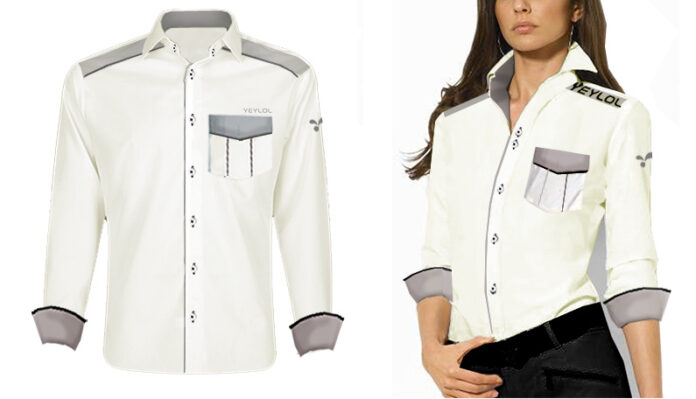In today’s fast-paced world, uniform design has evolved beyond practicality and functionality to incorporate elements of corporate fashion. Companies across various sectors are beginning to realize the importance of a well-designed uniform, which not only fosters team unity but also communicates the brand’s identity. The fusion of style and function in uniform design has become a key focus in the textile industry, with new trends emerging every year that reflect broader changes in fashion, technology, and sustainability.
The Role of Corporate Fashion in Uniform Design
Corporate fashion plays a significant role in shaping uniform design. Once, uniforms were only about function: providing employees with practical, durable clothing for the job at hand. Today, however, uniforms are an extension of a company’s brand image. Companies like airlines, hospitality chains, and retail stores understand that their employees’ attire impacts customer perceptions.
A well-designed uniform communicates professionalism, credibility, and unity. For instance, the fashion choices of multinational companies like Apple or Google are typically minimalistic, reflecting the tech industry’s focus on simplicity and innovation. By contrast, high-end hotels or luxury car brands often opt for more sophisticated, elegant uniforms that communicate their status and attention to detail.
Current Trends in Corporate Uniform Design
Several key trends have emerged in corporate uniform design, aligning with broader movements in the fashion and textile industries.
- Sustainability and Eco-Friendly Materials
As sustainability becomes more important in all aspects of life, it’s no surprise that the textile industry is also feeling the pressure to adopt eco-friendly practices. Many companies are now looking to create uniforms made from sustainable materials, such as organic cotton, recycled polyester, or bamboo fibers. These materials are not only kinder to the environment but also offer better comfort, durability, and breathability, making them ideal for everyday wear in the workplace.
Incorporating sustainable materials into uniform design also enhances the company’s image as a socially responsible entity. Brands like Patagonia and Stella McCartney have been at the forefront of this trend, creating uniforms for their staff that reflect their commitment to environmental conservation. This shift toward eco-conscious design is expected to grow as more companies take steps to reduce their carbon footprint.
- Comfort and Functionality
Today’s employees expect uniforms to be not only stylish but also comfortable. The rise of hybrid working environments, where employees may spend part of their day in the office and part working remotely, has led to a demand for more versatile uniforms. Breathable fabrics, ergonomic designs, and flexibility in fit are becoming more important in uniform design. Textiles that offer moisture-wicking properties, stretchability, and climate control are now in high demand, particularly in industries like healthcare, retail, and hospitality.
For example, many restaurants and cafes now choose uniforms that allow freedom of movement while being easy to clean, ensuring that employees feel both comfortable and presentable during long shifts. The rise of athleisure wear has also had a considerable influence on corporate fashion, inspiring designers to integrate elements like elastic waistbands and soft, durable fabrics into uniform design.
- Gender-Neutral and Inclusive Design
Another significant trend in uniform design is the movement toward gender neutrality and inclusivity. Traditionally, uniforms were designed with a clear distinction between male and female employees, often reinforcing outdated gender norms. However, many modern companies are embracing gender-neutral designs that accommodate all body types and personal preferences.
This trend is part of a larger shift toward inclusivity in fashion, with a focus on creating attire that works for everyone. Unisex uniforms are practical and allow employees to feel comfortable in what they wear without conforming to rigid gender stereotypes. In industries like retail and technology, where diverse workforces are celebrated, inclusive uniform designs help reinforce a company’s commitment to equality and representation.
Impact of Textile Industry Trends on Uniform Design
The textile industry has always played a vital role in shaping uniform design trends. Innovations in fabric technology and production methods are driving some of the most significant changes in uniform fashion today. As demand for smart fabrics and sustainable practices grows, the textile industry is evolving rapidly to meet new market needs.
- Smart Fabrics and Wearable Technology
The integration of technology into uniforms is an exciting trend in the textile industry. Smart fabrics, which are textiles embedded with electronic components, are being incorporated into uniform design to improve functionality and safety. For example, uniforms in the healthcare or construction sectors can now include sensors that monitor temperature, heart rate, or environmental hazards.
Wearable technology is also being used to create uniforms with enhanced functionality. Some uniforms now include RFID tags for easy identification or communication, while others have built-in GPS systems or lighting features for improved safety in hazardous working environments.
- Automation in Textile Production
The advent of automation and AI in textile production is changing how uniforms are designed and manufactured. Automated processes can streamline production, reduce waste, and offer more customization options for uniform designs. With automation, companies can create personalized uniforms tailored to employees’ specific measurements, ensuring a better fit and improved comfort.
In addition, digital printing technology allows for more intricate designs and faster production times. This trend is particularly relevant for businesses looking to create unique, branded uniforms that stand out from the competition. The ability to quickly produce high-quality, customized uniforms is an essential competitive advantage in today’s fast-paced corporate fashion landscape.
Conclusion
The world of uniform design is evolving rapidly as corporate fashion and textile industry trends converge. Companies now understand the importance of uniforms in communicating brand identity and values, and are increasingly adopting designs that reflect broader fashion trends. Whether it’s through the use of sustainable materials, smart fabrics, or gender-neutral designs, the future of uniforms is one that combines style, comfort, and functionality.
As the textile industry continues to innovate, we can expect even more exciting developments in the world of uniform design. From eco-friendly production practices to wearable technology, the future of corporate fashion is bright, reflecting the ongoing transformation of the global workplace.


